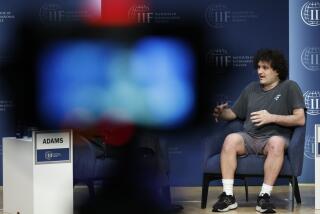BOOK REVIEW : The ‘Final Word’ on the Piltdown Man Hoax : PILTDOWN: A Scientific Forgery <i> by Frank Spenser</i> Oxford University Press $22.95, 290 pages. : THE PILTDOWN PAPERS 1908-1955 Oxford University Press $59.95, 294 pages
- Share via
There is something essentially genteel about the tale of the phony fossil known as Piltdown Man. The ingeniously contrived hoax fooled two generations of gentlemen scientists before being exposed in 1954 as an orangutan’s jaw and teeth joined to a human cranium. Since then, the list of possible perpetrators has been examined by a string of scientist-sleuths, whose fingers have pointed successively at figures as diverse as Arthur Conan Doyle and Teilhard de Chardin.
Now we have a book claiming to be the last word on the scam: “Piltdown: A Scientific Forgery” by Frank Spenser, which comes with “The Piltdown Papers, 1908-1955,” the paper trail that Spenser followed to his solution.
To recap the events: Sometime between 1908 and 1911, Charles Dawson, a solicitor in Lewes, Sussex, England, reported that a laborer working in nearby Piltdown had found something that looked like a shattered coconut in a gravel pit. The laborer gave a fragment of the object to Dawson, who recognized it as part of a human skull.
Dawson went to the site and gathered eight more skull pieces as well as a fossil hippopotamus tooth. He reported his finds to Arthur Smith Woodward, at the Natural History Museum in London, who came to the site with the Jesuit scientist Chardin. The three found more teeth of extinct animals, and, at another site nearby, evidence of early man.
Also involved were Arthur Keith, of the Hunterian Museum at the Royal College of Surgeons, who had a special interest in human evolution; Lewis Abbot, a friend of Dawson and Woodward who was a jeweler and amateur paleontologist in nearby Hastings, and Martin Hinton, a volunteer at the British Museum until appointed deputy keeper in zoology in 1921. Current opinion agrees that Dawson was a culprit but with a hitherto unnamed collaborator.
Spenser eliminates possible suspects until he stops at Arthur Keith. Not only was Keith capable of the chemistry necessary to produce a fake, but he had access at the museum to the fossil teeth “seeded” at the sites. Above all, he was in touch with Dawson, who alone had the opportunity to plant the fakes. Spenser reveals Keith as the author of an anonymous paper that appeared only three days after the announcement of the discovery at the Geological Society. Finally, he shows how Piltdown ensured Keith’s academic reputation.
So what does it all matter today? No one suffered, and eventually truth did out. Given that Piltdown caused mischief, delaying for decades, perhaps, the current understanding of hominid evolution, is there more than the fascination of skulduggery unveiled to be gleaned from this story?
Of course there is. For one, the ease with which the scientific community swallowed the fraud must be examined. From the announcement of the strange fossils in 1912 until 1954, when the whole episode was blown open with the aid of new dating technologies, scientists avoided the possibility that Piltdown was a deliberate fraud.
As early as 1915, an American, Gerrit Miller, studied the skull and concluded that “on the basis of the evidence furnished by the Piltdown fossils and by the characters of all the men, apes and monkeys now known, a single individual cannot be supposed to have carried this jaw and skull.”
Scientists seldom suspect fraud, partly because science is self-correcting--as it was with Piltdown--and partly because science at that time was a gentleman’s occupation, indulged in by members of the club who knew the rules.
This club in Britain was nationalistic (fossils had been found in France and Germany; why not Britain?) and racist--eager to discount Africa as the place to look for human beginnings. “Piltdown” is a cautionary tale. The hoax would never have gained such wide acceptance but for the smugness of the narrow scientific world in which it all occurred.
Next: Jonathan Kirsch reviews “In the Shadow of the Holocaust” by Aaron Hass (Cornell University Press).
More to Read
Sign up for Essential California
The most important California stories and recommendations in your inbox every morning.
You may occasionally receive promotional content from the Los Angeles Times.













